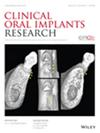局部因素在种植体周围炎发生中的作用:横断面分析。
IF 5.3
1区 医学
Q1 DENTISTRY, ORAL SURGERY & MEDICINE
引用次数: 0
摘要
目的:通过一项横断面研究来评估局部因素(包括手术、种植体和假体相关参数)在种植体周围炎中的作用。方法纳入连续出现种植体≥1颗的部分无牙患者。收集临床和影像学资料以确定局部因素。总的来说,28个位点特异性变量分析了种植体周围炎和非种植体周围炎种植体。进行简单和多元逻辑回归分析以探索潜在的关联。进一步检验多元逻辑回归分析中具有统计学意义的变量的诊断准确性。结果100例患者共452颗种植体符合纳入标准。其中,227个种植体(50.2%)被诊断为种植体周围炎,而225个(49.8%)未出现种植体周围炎。多元logistic回归分析显示以下因素具有统计学意义:(1)种植体内内侧位置(OR = 3.9)更容易发生种植体周围炎;(2)内莫尔斯锥度种植体连接最不容易发生种植体周围炎(OR = 0.43);(3)中远端为中心的种植体不容易出现种植体周围炎(OR = 0.46);(4)颊-舌中心种植体较不容易出现种植体周围炎(OR = 0.29);(5)位于骨壳内(≥2mm)的种植体不容易出现种植体周围炎(OR = 0.13);(6)种植体倾斜10°-30°(OR = 5.84)和≥30°(OR = 7.43)的种植体更容易出现种植体周围炎。此外,基于上述因素的预测模型产生了高水平的准确性。结论种植体错位是引起种植体周围炎的重要因素。本文章由计算机程序翻译,如有差异,请以英文原文为准。
Role of Local Factors on the Occurrence of Peri-Implantitis: A Cross-Sectional Analysis.
OBJECTIVE
A cross-sectional study was made to evaluate the role of local factors, including surgical, implant, and prosthesis-related parameters, in the presence of peri-implantitis.
METHODS
Consecutive partially edentulous patients with ≥ 1 implant presenting peri-implantitis were included. Clinical and radiographic data were collected to characterize local factors. Overall, 28 site-specific variables were analyzed for peri-implantitis and non-peri-implantitis implants. Simple and multiple logistic regression analyses were performed to explore potential associations. The diagnostic accuracy of those variables that demonstrated statistical significance in the multiple logistic regression analysis was further tested.
RESULTS
In total, 100 patients with 452 implants met the inclusion criteria. Of these, 227 implants (50.2%) were diagnosed with peri-implantitis, while 225 (49.8%) did not present peri-implantitis. The multiple logistic regression analysis demonstrated statistical significance for the following factors: (1) medial implant position within the prosthesis (OR = 3.9) was more prone to develop peri-implantitis; (2) internal Morse taper implant connection was the least likely to develop peri-implantitis (OR = 0.43); (3) mesio-distally centered implants were less prone to exhibit peri-implantitis (OR = 0.46); (4) bucco-lingual centered implants were less prone to exhibit peri-implantitis (OR = 0.29); (5) implants positioned inside (≥ 2 mm) the bony housing were less prone to exhibit peri-implantitis (OR = 0.13); and (6) implants tilted 10°-30° (OR = 5.84) and ≥ 30° (OR = 7.43) were more prone to exhibit peri-implantitis. Moreover, a prediction model based on the aforementioned factors yielded a high level of accuracy.
CONCLUSIONS
Implant malpositioning is a critical factor associated with peri-implantitis.
求助全文
通过发布文献求助,成功后即可免费获取论文全文。
去求助
来源期刊

Clinical Oral Implants Research
医学-工程:生物医学
CiteScore
7.70
自引率
11.60%
发文量
149
审稿时长
3 months
期刊介绍:
Clinical Oral Implants Research conveys scientific progress in the field of implant dentistry and its related areas to clinicians, teachers and researchers concerned with the application of this information for the benefit of patients in need of oral implants. The journal addresses itself to clinicians, general practitioners, periodontists, oral and maxillofacial surgeons and prosthodontists, as well as to teachers, academicians and scholars involved in the education of professionals and in the scientific promotion of the field of implant dentistry.
 求助内容:
求助内容: 应助结果提醒方式:
应助结果提醒方式:


